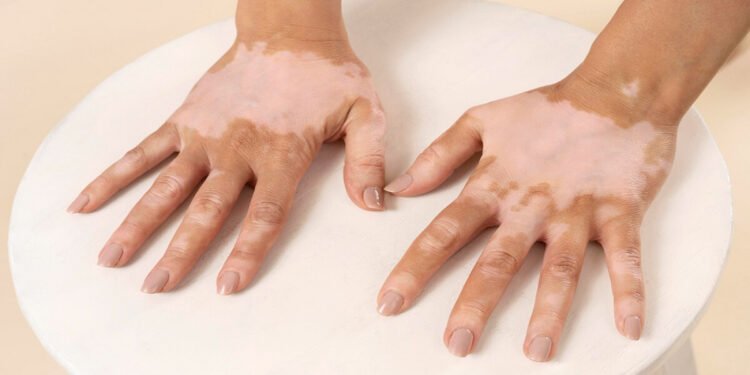What is leucoderma or vitiligo? – an Overview

In simple terms, vitiligo can be defined as a skin disorder that causes the skin to lose its original color. Smooth white areas that are less than 5 mm are called macules and smooth white areas larger than 5mm or in the size of 5mm are called patches. These macules or patches appear on the skin of a person. This condition of the skin losing its original color occurs when the melanocytes that produce melanin or pigmentation are destroyed by the immune system of the body. It mostly affects the hands, forearms, face, and feet. This article focuses on providing you with guidelines on how to cure leucoderma or vitiligo.
Various vitiligo types:
The types of vitiligo are :
● Focal
This is one of the rarest types as the macules present in a certain or specific pattern in the body do not spread to other parts of the body for at least one or two years. The macules are also present in a small area only.
● Generalized
This is a condition in which the macules appear in different or various parts of the body.
● Mucosal
In this type of vitiligo, the membranes of the mouth or the genitals get affected.
● Segmental
This type of vitiligo is restricted to one particular side of the body or it can also affect one area such as the face or the hands.
● Universal
The universal type is another rare type of leucoderma or vitiligo. In this type, the body loses more than 80% of pigmentation.
● Trichome
The trichome type is a condition in which there is a colorless or white center, then an area of pigmentation that is lighter, and then an area or part of normally colored skin.
How common is vitiligo or leucoderma ?
Statistics report that leucoderma affects 1% or slightly more than 1% of the population around the globe.
What are the warning signs that can show the onset of leucoderma or vitiligo?
- Skin areas that have been exposed to the sun will become lighter in color.
- when there is an injury to the skin that results in the pigmentation of the skin becoming more white.
- Exposure to the sun, severe heat, or excessive sweating can cause innocuous white patches on the skin to itch.
- If the skin on the face, hands, and other parts of the body begins to lose its pigmentation
- Changes in the color of the retina
In most cases, depigmentation is a painless procedure. They might begin as tiny patches and expand significantly in size.
Understanding the causes of leucoderma:
The cause of vitiligo is still not quite evident, however there are a variety of theories as to what causes it.
Autoimmune concerns:
A person’s immune system may produce antibodies that attack and kill melanocytes in the affected individual. Vitiligo is more common in people with autoimmune diseases such psoriasis, systemic lupus erythematosus, Hashimoto’s disease, and alopecia areata.
Genetic studies have found links between several additional autoimmune diseases, including vitiligo and rheumatoid arthritis, type 1 diabetes, and hypothyroidism as well. One in four people who have vitiligo also suffer from a separate autoimmune disorder.
Genetic factors: Some of the risk factors for developing vitiligo can be inherited. Vitiligo tends to run in families in about 30% of instances.
Neurogenic factors: The skin’s nerve endings may emit a chemical that is harmful to melanocytes.
Physical and emotional stress have been linked to vitiligo in the past. It’s probable that vitiligo is caused by a combination of these causes, as none of them seem to explain the disorder completely.
Environmental factors: This condition, known as vitiligo, appears to be the result of a combination of genetic predisposition and environmental triggers. Sunburn, contact with certain chemicals, and trauma or injury to the skin are all possible triggers. People who already have vitiligo may have their condition worsen if they are exposed to these stressors.
Available options to treat leucoderma:
This condition is not life-threatening and does not spread via direct contact with someone who has it. As of now, there is no cure for vitiligo, but sufferers can take advantage of a range of treatment choices to keep the disorder under control, these options are recommended by a leucoderma specialist doctor. Only a few of them are:
Medications: Depigmentation can lead to skin irritation and other side effects, thus dermatologists recommend topical creams and ora tablets to assist repigment and control these issues.
Light therapy: Narrow-band ultraviolet – B (311) phototherapy and oral psoralen and UVA – PUVA therapy are the two most widely utilized forms of light therapy for vitiligo treatment. Upper-body leukoderma is better treated with PUVA than with PUVA.
Surgery: Skin grafts is a procedure that involves the removal of normal skin from one part of the body and is utilized to cover the damaged area is a typical therapeutic procedure for vitiligo. Blister grafting is a related method that is also utilized.
Successful treatment of leucoderma’s major goal is to darken the lightened skin areas and prevent them from spreading further. Applying skin tanners or makeup to the affected area, especially if the condition is still in its early stages, is still the safest alternative rather than using the procedures listed above.
In most cases, it’s a condition that persists for the rest of one’s life. It’s unclear what’s causing this, but it could be an autoimmune disease or a virus. Vitiligo does not spread like a virus. In severe cases, the best vitiligo treatment options may include sun exposure (UVA or UVB light) and skin depigmentation.
Recovery from leucoderma:
Approximately 10% to 20% of persons who suffer from vitiligo are able to restore their skin color. Vitiligo sufferers who are under the age of 30 have the highest chance of returning to their pre-vitiligo appearance, as long as the disease has not spread to other parts of the body. Those who get vitiligo on their lips and limbs, particularly the hands, later in life have a lower chance of regaining their natural pigment.
The conclusion derived from the article is that with the early stages of detection or diagnosis and with the right type of treatment in the best hospital for leucoderma, leucoderma can be cured.






